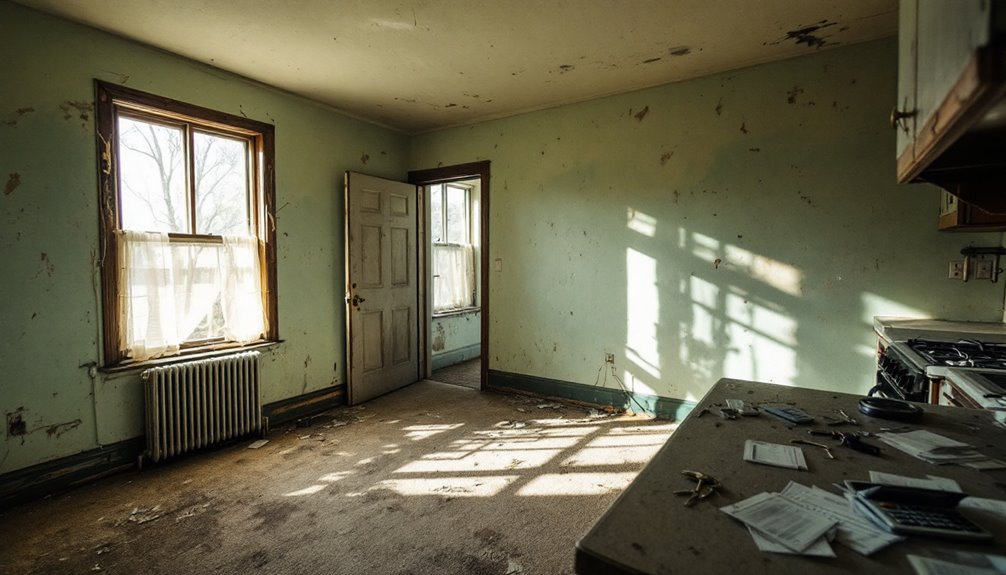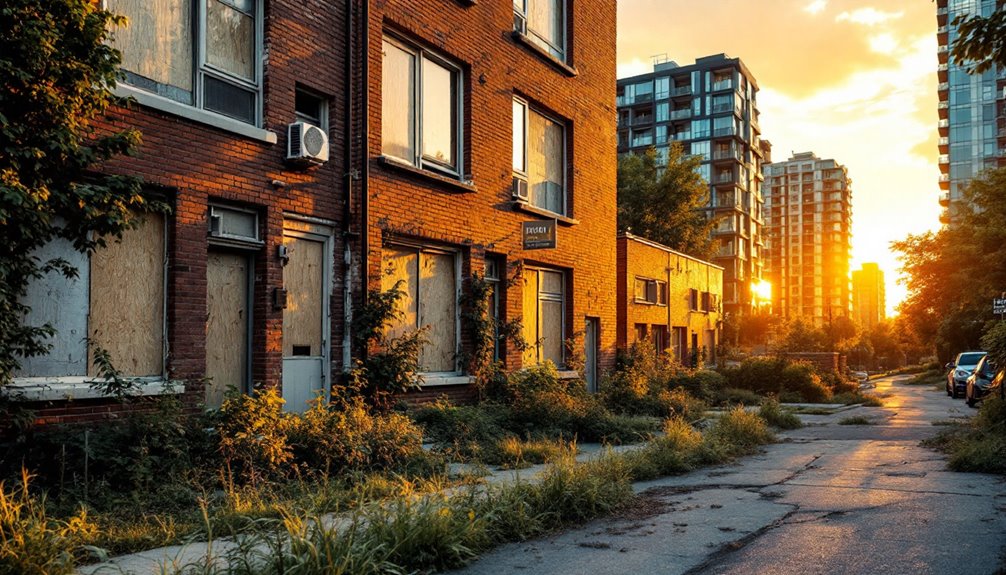Rent control creates a complex trade-off in housing markets. While it helps current tenants by limiting rent increases and providing housing stability, it often damages the overall market. Studies show it reduces rental supply by up to 10% as landlords convert properties to other uses. Property owners face maintenance challenges and declining values, leading to reduced investment in rental housing. For every tenant protected, the policy appears to create unintended ripple effects that reshape entire neighborhoods.
Key Takeaways
- Rent control provides immediate relief to tenants through predictable housing costs and protection from sudden rent increases.
- Studies show rent control reduces rental housing supply by approximately 10% as landlords convert properties to other uses.
- Property maintenance often declines under rent control, with 60% of landlords deferring repairs due to limited revenue.
- Tenants in rent-controlled units experience greater housing stability and are less likely to move within 5-10 years.
- Long-term market effects include decreased new construction, reduced property values, and creation of inefficient dual rental markets.
The Core Purpose of Rent Control

Why do cities implement rent control policies? The primary reason is to address housing affordability in areas where rental costs are rising rapidly. Under landlord-tenant law, rent control places limits on how much property owners can increase rent prices, protecting tenants from excessive increases that could force them out of their homes.
Rent control typically appears in high-demand urban areas where housing costs outpace local wages. Cities like New York and San Francisco use these regulations to maintain affordable housing options for residents. The policy creates a system where local housing authorities or rent control boards oversee and enforce specific caps on rent increases. While implementations vary by location, the fundamental goal remains consistent: preventing landlords from raising rents to unaffordable levels and helping tenants maintain stable housing costs in competitive markets.
Tenant Benefits and Protections
Rent control offers tenants several key advantages that improve their quality of life and financial security. The policy creates housing stability by limiting annual rent increases to specific percentages, which allows renters to maintain their established community connections and avoid sudden displacement. Monthly housing costs become more predictable under rent control, enabling tenants to budget effectively and potentially build savings for their future needs.
Enhanced Housing Stability
Through extensive tenant protections, housing stability emerges as one of the most substantial benefits of rent control policies. Studies show that rent stability markedly reduces tenant turnover, with residents being 19 percent less likely to move within a five to ten-year period. Protection against displacement particularly benefits minorities and those with strong neighborhood connections.
Key aspects of enhanced housing stability include:
- Tripled expected duration of residence in rent-controlled units
- Stronger community ties due to longer tenancy periods
- Protection for tenants with local commitments like schools and jobs
- Legal recourse and rights against unfair landlord practices
This stability allows tenants to build lasting connections within their communities while maintaining affordable housing options. The combination of rent predictability and legal protections creates a foundation for long-term residential security.
Predictable Monthly Costs
A cornerstone benefit of rent control policies lies in their ability to provide tenants with predictable monthly housing costs. These regulations establish clear limits on both initial rent amounts and subsequent increases, allowing residents to budget effectively for their housing expenses. For example, a tenant in a rent-controlled apartment can reliably anticipate their housing costs for the upcoming year.
Regulated rent increases under these policies typically follow specific formulas, often tied to the consumer price index or fixed percentages set by local law. This protection shields tenants from sudden, dramatic rent hikes that could otherwise force them to relocate. The predictable monthly costs enable families to make informed financial decisions, save for the future, and maintain stable housing situations. This financial consistency particularly benefits long-term residents who wish to remain in their communities.
Protection From Displacement
Beyond predictable costs, one of the most significant features of rent control policies is their ability to shield tenants from displacement. These regulations provide essential protection from displacement through multiple safeguards that help maintain housing stability for residents, particularly those with strong community ties.
Key displacement protections include:
- Prevention of arbitrary evictions by requiring landlords to provide valid reasons for tenant removal
- Caps on annual rent increases, typically between 7-10%, preventing sudden cost spikes
- Mandatory relocation assistance for no-fault evictions, covering moving expenses
- Right of return guarantees for units temporarily removed for rehabilitation
These measures promote long-term housing stability, allowing families to maintain their social networks, job proximity, and children's education without constant fear of displacement. This security particularly benefits low and moderate-income residents who have invested in their communities.
Impact on Local Housing Supply

Studies show that rent control policies lead to significant reductions in available rental housing units, with research indicating a nearly 10% decrease in overall rental supply. Property owners often respond to rent control by converting rental properties into condominiums or owner-occupied homes, effectively shrinking the rental market. Additionally, developers become hesitant to build new rental properties in rent-controlled areas, as the restrictions limit their potential returns on investment.
Rental Unit Availability Drops
Through extensive research across multiple cities, data reveals that rent control policies consistently lead to significant reductions in rental housing supply. Studies demonstrate substantial drops in available units following the implementation of rent control measures, with some cities experiencing dramatic declines.
Key findings show:
- Santa Monica saw an 8.7% reduction in rental housing supply after implementing rent control
- Berkeley experienced a 7.5% decrease in available rental units
- Overall rental supply dropped by 9.9% following rent stabilization reforms
- Units for households above 120% AMI decreased by 38%
These reductions stem from landlords converting rental properties to condominiums or selling them to avoid rent control restrictions. The decreased housing quality also contributes to unit loss, as property owners reduce maintenance and improvements due to limited financial incentives under rent control policies.
New Construction Slows Down
Despite widespread concerns about rent control's negative impact on new housing development, research presents a more nuanced picture. Studies in New Jersey and Washington, DC found no direct relationship between rent control and reduced housing supply, with new construction responding more to broader economic factors.
However, developer sentiment tells a different story. Over 85% of multifamily developers report avoiding areas with rent control, citing concerns about future profitability. This hesitation exists even when policies exempt new construction from controls, which is common in most rent-controlled jurisdictions.
The reality lies somewhere in between. While macroeconomic factors primarily drive new construction decisions, rent control can influence where developers choose to build. Some opt to shift their projects to nearby cities without restrictions, potentially affecting local housing supply distribution rather than overall construction levels.
Economic Effects on Property Owners
Rent control policies create substantial financial burdens for property owners across multiple areas of their business operations. The impacts directly affect property values and rental income while constraining the housing supply. Research shows landlords face mounting pressure to sell assets or convert properties to condominiums to escape these restrictions.
Key financial impacts on property owners include:
- Property values can drop markedly – Boston projected a $260 million decrease under a 3% rent cap
- Tax revenue losses reach millions annually, with NYC losing $4 billion in taxable assessed value
- 67% of housing providers refuse to invest in markets with strict rent control
- 54% of property owners consider selling assets due to financial strain
These economic pressures often force landlords to reduce property maintenance or exit the rental market entirely, further diminishing the available housing supply.
Changes in Property Maintenance

When property owners face financial constraints under rent control policies, they often respond by reducing essential maintenance and property improvements. Studies show that over 60% of housing providers defer nonessential maintenance due to limited revenue from rent-controlled units.
The impact on housing quality is significant and measurable. Properties under rent control experience a 24.9% increase in cockroach problems and a 12.8% rise in rodent infestations. Water service interruptions and electrical issues become more common as maintenance spending decreases. When the number of rent-controlled units doubles, moderately inadequate housing rises by 14.7%, while severe housing inadequacies increase by 16.2%.
These changes affect entire neighborhoods, leading to declining property conditions and reduced public services due to lower property tax revenues.
Market Dynamics and Pricing
Three key market forces emerge when examining the impact of rent control policies on housing markets. The interaction between housing supply, rental prices, and tenant distribution creates complex market dynamics that affect both landlords and renters.
The primary effects of rent control include:
- Reduced housing supply as property owners become hesitant to invest in new construction
- Creation of a dual market where uncontrolled units see price increases to offset controlled units
- Uneven distribution of benefits, favoring long-term tenants over new renters
- Market inefficiencies leading to housing shortages and decreased maintenance
These market dynamics often result in an environment where fewer rental units are available, and the quality of existing housing stock deteriorates. The economic consequences extend beyond simple price controls, affecting the overall health of the housing market and potentially reducing access to affordable housing for future tenants.
Small Landlord Challenges

Beyond the broader market effects, small landlords face distinct challenges under rent control policies that threaten their ability to maintain profitable operations. These property owners experience significant financial strains when they cannot raise rents to match rising maintenance costs. For example, in New York, caps on rent increases for apartment improvements mean landlords might need 200 years to recover a $200,000 renovation investment.
Compliance challenges further burden small landlords, with 28% reporting difficulties coping with complex landlord-tenant laws. These regulations restrict their ability to manage properties effectively, from signing new tenants to handling evictions. As a result, many small landlords either turn to stricter management companies or convert their buildings to condominiums to escape rent control restrictions, ultimately reducing the available rental housing stock.
Housing Quality Concerns
A major concern with rent control policies lies in their detrimental effect on housing quality. Studies consistently show that rent-controlled buildings experience significant deterioration over time due to reduced maintenance and repairs. When landlords cannot increase rents to match market rates, they often minimize property investments, leading to declining housing conditions.
Key findings demonstrate that rent control affects housing quality through:
- Reduced spending on essential maintenance, as landlords cannot recoup investment costs
- Higher rates of building deterioration compared to non-controlled properties
- Limited property improvements due to restricted rental income
- Decreased overall building conditions, with 63% of rent control benefits in Los Angeles offset by housing deterioration
This pattern of declining housing quality creates long-term challenges for both tenants and communities, ultimately undermining the intended benefits of rent control policies.
Long-Term Market Implications

While housing quality concerns represent immediate effects of rent control, the policy's long-term market implications reach far deeper into the housing ecosystem. Studies show that rent control substantially reduces housing supply, with over 70% of housing providers scaling back or abandoning development plans in controlled markets. This decrease in supply creates a ripple effect throughout the regional housing market.
The economic implications extend beyond individual properties. Local governments face reduced property tax revenues as rental property values decline, affecting their ability to fund essential services and infrastructure. In addition, the policy creates a two-tiered market where controlled units become increasingly scarce while uncontrolled units experience price surges. This market distortion discourages new investments in rental housing and often diverts construction toward for-sale properties instead of rental units.
Social Equity Considerations
Social equity stands at the forefront of rent control debates, revealing complex patterns of benefit distribution across different demographic groups. While rent control policies aim to protect vulnerable populations, their impact varies substantially across racial and economic lines.
Research shows that rent control can enhance housing stability through:
- Protection of low-income communities from displacement, with potential income gains of 13% for Black households
- Reduction in eviction rates, particularly benefiting women of color
- Improved health and educational outcomes due to stable housing
- Enhanced civic engagement in communities of color
However, challenges persist as access to rent-controlled units remains uneven. Black tenants are 5% less likely to occupy rent-stabilized units than white tenants, and benefits often favor long-term, higher-income residents. This raises questions about whether rent control effectively addresses social equity goals.
Neighborhood Stability Analysis

Three key dimensions shape neighborhood stability under rent control policies: tenant longevity, housing quality, and market dynamics. Studies show that rent control substantially increases the likelihood of tenants staying in their homes, with beneficiaries being 10-20% more likely to remain in their units. This stability creates stronger community ties and better health outcomes, particularly for children.
However, the impact on housing quality presents challenges to neighborhood stability. Landlords often reduce maintenance and delay repairs in rent-controlled buildings, leading to deteriorating conditions. This neglect can affect nearby properties, creating a ripple effect throughout the neighborhood. Additionally, some property owners may convert rental units to other uses or remove them from the market entirely, potentially disrupting established community patterns and reducing available housing options.
Alternative Housing Solutions
Facing unprecedented housing challenges, communities across the United States are exploring alternatives to rent control that address affordability and accessibility. With only 34 affordable rental homes available per 100 extremely low-income households, policymakers are implementing diverse solutions beyond traditional rent control measures.
Key alternative approaches include:
- Expanding housing voucher programs, which helped over 60,000 households secure permanent housing
- Investing in Permanent Supportive Housing (PSH), adding 36,737 new units in 2022-2023
- Increasing emergency rental assistance programs, preventing 800,000 evictions during 2020-2021
- Developing more affordable housing supply through targeted investments and zoning reforms
These solutions demonstrate that addressing housing affordability requires a multi-faceted approach rather than relying solely on rent control policies. Evidence suggests that expanding housing supply and providing direct assistance produce measurable results in stabilizing housing markets.
Cost-Benefit Assessment

Thorough analysis of rent control reveals a complex balance of benefits and drawbacks for both tenants and the housing market. While current tenants benefit from immediate affordability and increased housing stability, especially among minority communities and long-term residents, the broader economic consequences are significant.
The policy's impact on housing supply creates concerning trends, as landlords often convert rental properties to condominiums or owner-occupied units, reducing available rental stock by 15% to 25%. Property values typically decrease under rent control, leading to reduced tax revenue and decreased investment in maintenance. For example, when Cambridge removed rent control, property values increased by $2.0 billion over ten years. These findings suggest that while rent control provides short-term relief for some residents, it may compromise long-term housing affordability and market efficiency.
Policy Implementation Challenges
The implementation of rent control policies requires substantial government resources for monitoring compliance and enforcement across diverse property types. Local housing authorities face challenges in tracking multiple rental units while ensuring fair treatment of both landlords and tenants under complex regulatory frameworks. These implementation difficulties are further complicated by the need to balance competing interests between property owners seeking reasonable returns on investment and tenants advocating for affordable housing protections.
Enforcement Costs and Resources
Implementation of rent control policies demands substantial financial and administrative resources from local governments. The fiscal costs associated with regulatory compliance and enforcement mechanisms create significant budgetary challenges for municipalities.
Local housing agencies must maintain robust systems to:
- Process and verify landlord expense documentation for rent increase requests
- Conduct regular building inspections to guarantee maintenance standards
- Handle tenant complaints and legal disputes efficiently
- Monitor and enforce annual rent adjustment guidelines
These administrative requirements necessitate adequate staffing, technology infrastructure, and ongoing training. Additionally, municipalities often face reduced property tax revenue due to lower property values under rent control, further straining available resources. The complex nature of enforcement requires continuous updating of legal frameworks and regulatory procedures, making it essential for local governments to allocate sufficient funding to maintain effective oversight of rent-controlled properties.
Monitoring Multiple Property Types
Beyond the general enforcement challenges, monitoring different types of rental properties presents unique complexities for local housing authorities. Housing officials must track various property categories, from large apartment complexes to single-family homes, each with distinct rent control requirements. This diversity in housing supply makes it difficult to maintain consistent oversight and guarantee compliance across all property types.
For example, a housing authority might need different monitoring approaches for historic buildings versus modern developments, as each property type faces unique maintenance challenges that affect property values. Additionally, some properties may qualify for exemptions or different regulations based on their age, size, or ownership structure. These variations require housing authorities to develop flexible monitoring systems and maintain detailed records for each category of rental housing.
Balancing Competing Stakeholder Interests
Successful rent control policies require a delicate dance between protecting tenant rights and maintaining landlord incentives to invest in properties. Local governments must carefully weigh competing interests when implementing rent control measures, as both tenants and property owners have legitimate concerns about housing affordability and financial viability.
Key challenges in balancing stakeholder interests include:
- Determining appropriate annual rent increase caps that protect tenants while allowing reasonable returns for landlords
- Implementing tenant protections without overly restricting property owners' ability to maintain their buildings
- Ensuring adequate housing supply by providing incentives for new construction and property improvements
- Creating enforcement mechanisms that are fair and effective for both parties
The most effective rent control policies find middle ground through data-driven approaches, regular policy reviews, and ongoing dialogue between tenant advocates and property owners.
Future Market Outlook

Market projections indicate that rent control policies will continue to shape housing dynamics in significant ways. Based on current trends, the housing supply is likely to face ongoing constraints in cities maintaining strict rent control measures, potentially worsening existing shortages. Housing quality may deteriorate further as property owners struggle to justify maintenance costs under regulated rents.
The economic consequences could become more pronounced, with declining property tax revenues and increased market distortions. Cities may see more conversions of rental properties to condominiums or other uses, reducing available rental stock. This transformation could accelerate the shortage-inflation spiral, particularly in desirable urban areas. While some municipalities are exploring "second generation" rent control policies that offer more balanced approaches, the overall outlook suggests continued challenges in achieving equilibrium between tenant protection and market sustainability.
Frequently Asked Questions
How Do Inheritance Laws Affect Rent-Controlled Properties When Landlords Pass Away?
When landlords pass away, inheritance laws guarantee that rent-controlled properties transfer smoothly to heirs or new owners. The existing lease agreements remain valid, and the administrator can collect rent during the handover. If there's a surviving spouse, the property typically passes to them automatically. Heirs must continue following rent control regulations and cannot easily evict tenants. This system protects tenants while allowing for property ownership handover through inheritance.
Can Tenants Legally Sublet Their Rent-Controlled Apartments on Airbnb?
Like playing real estate roulette with someone else’s chips, subletting a rent-controlled apartment on Airbnb is typically not legal without explicit landlord permission. Most jurisdictions require tenants to obtain written consent and comply with local short-term rental regulations. Even if permission is granted, tenants must navigate complex rules including primary residence requirements, registration permits, and rental duration caps. Violations can result in eviction and hefty fines for both tenant and landlord. Additionally, landlords who discover unauthorized subletting may withhold deposits or pursue legal action, leaving tenants financially vulnerable. To avoid potential disputes, it’s crucial to review lease agreements carefully and understand how to get your security deposit back if faced with eviction or penalties. Taking proactive steps, such as open communication with the landlord and adherence to local rental laws, can help tenants avoid costly consequences.
What Happens to Rent Control During Natural Disasters or State Emergencies?
During natural disasters or state emergencies, rent prices typically increase by 4-6% due to reduced housing availability. Some states implement temporary price gouging rules to prevent sharp rent increases, though these protections usually expire after a few months. Areas may also enact eviction moratoria, like Sonoma County's automatic policy during disasters. Federal programs like CDBG-DR can help slow rent appreciation, but without permanent protections, renters remain vulnerable to post-disaster rent hikes.
Do Rent Control Laws Apply Differently to Commercial Versus Residential Properties?
In a world where property rules are as complex as rocket science, rent control laws do apply differently between commercial and residential properties. Commercial properties rarely have rent control, giving landlords more flexibility in setting rates and terms. Meanwhile, residential properties often have strict rent control regulations to protect tenants from excessive increases. For example, a residential landlord might be limited to 3% annual increases, while commercial landlords can adjust rates freely.
How Do Rent Control Regulations Affect Property Insurance Rates and Coverage?
Rent control regulations substantially impact property insurance rates and coverage options. Properties under rent control often face higher insurance premiums, typically 25% more than standard policies, due to increased maintenance risks. Insurance companies view these properties as higher-risk investments because landlords may defer upkeep when they can't raise rents to cover costs. This leads many landlords to choose higher deductibles or reduced coverage to manage expenses.
Conclusion
Rent control remains a complex policy with both benefits and drawbacks. While it protects current tenants, provides housing stability, and maintains neighborhood diversity, it also reduces housing supply, limits property investment, and creates market inefficiencies. As cities continue to face housing challenges, policymakers must balance tenant protection with market dynamics. The path forward requires careful analysis, innovative solutions, and flexible approaches that address both immediate needs and long-term sustainability.
